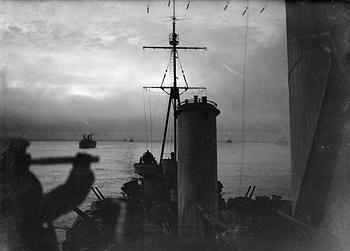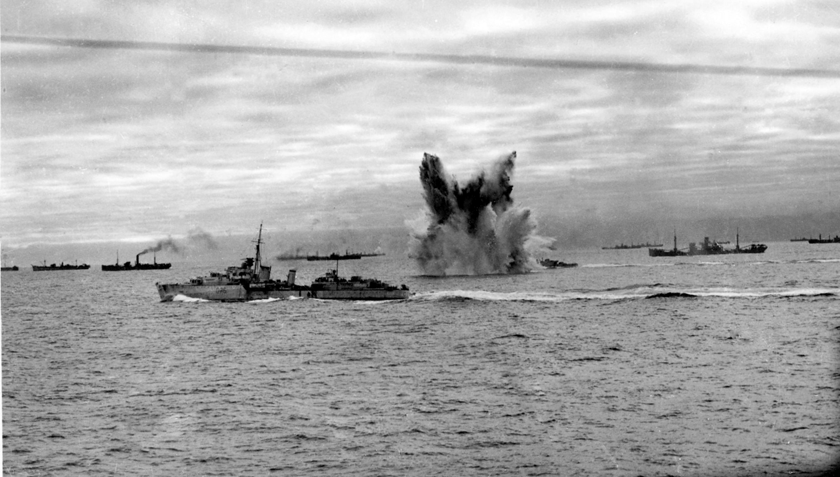
Arctic convoys during World War II

In the background, a scene of a depth charge explosion fired from a British destroyer is visible, behind it is a fragment of a convoy to the USSR. The destroyer HMS Eskimo is visible in the foreground. Eskimo's name is very
happening on the spot...
Naval warfare in the Arctic was centered around convoys. The main goal of the activity was to maintain communication lines with the USSR, so that critical Lend-Lease supplies could be effective. This determined the successful conduct of the most important operations on the Eastern Front, which were of decisive importance for the fate of the Great Patriotic War. For this reason, transports to Arkhangelsk and Murmansk were of inestimable importance.
The need to send convoys of allies with weapons and military equipment to the Soviet Union forced them to conduct operations at sea in the most difficult climatic conditions, in stormy weather, at extremely low temperatures and on a floating ice floe. The polar climate is formed by the Greenland High (Arctic) High. It is characterized by constantly negative air temperatures, up to several tens of degrees below zero Celsius, and small annual precipitation. The subpolar climate is characterized by constant low temperatures and their slight fluctuations. The average daily air temperature of the warmest month reaches 10°C. In late autumn and early winter, the weather conditions are stable, the sky is clear. In summer, the weather is humid and foggy, with occasional blizzards and rain.

Frosts meant that ships and ships bound for the USSR were covered with a thick layer of ice, which had to be shackled with picks, hammers and axes to avoid overloading.
The expansion of the glaciation of the Arctic Ocean in winter meant that convoy routes in winter had to be directed south, closer to the Norwegian coast. The great difficulty of this period was the arctic night prevailing here (above the 77th parallel), which made it very difficult to maintain order in convoys, since the running lights had to be turned off. However, at the same time, the polar night limited the actions of enemy aircraft and made it difficult for submarines to detect targets. In summer, by contrast, convoys made a wider circumnavigation of Norway, but for a change, the prevailing polar day meant that enemy aircraft could operate all the time, around the clock.
The Arctic convoys were originally codenamed PQ, with the following number derived from the initials of the operations officer who planned them, Commander. Lieutenant Philip Quellin Roberts. Return convoys were denoted by reverse letters - QP. In total, by September 1942, 18 PQ convoys and 15 QP convoys had been carried out. There were fewer returns because not all ships reached their destination, so sometimes they were grouped from two consecutive convoys. Later, when Comdr. Lieutenant Roberts left to command the submarine base HMS Bonaventure, the convoy code names were changed to JW. For those who travel to the east and RA for repatriates. In total, from December 1942 to May 1945, 22 convoys were carried out en route to the USSR and 21 in the opposite direction. In total, 41 convoys reached the USSR, and the ships returned back as part of 36 convoys.
Ships in convoys moved in columns separated by half a mile (about 900 m), and ships moved in separate columns for about a quarter of a nautical mile (about 450 m). Individual ships are marked with a two-digit number, the first digit is the column number (from left to right), and the second digit is the ship number in the column. One of the ships was the flagship of the convoy and its captain was also the commodore of the convoy. He could make decisions about changing the scheme, route, etc. In turn, the commanders of the escort ships made decisions related to military operations in the defense of the convoy. Neither of them was the boss of the other. However, when it was necessary to make a decision that could contradict the commander of the convoy and the commander of the escort, the decision of the latter was by definition valid, and the commander was binding. As a rule, there was consensus between the decisions of both, and there were no major conflicts between the escort commander and the commander, in practice the system worked well.
Later, rescue teams were added to the convoys, whose task was to pick up survivors from sunken ships. Rescue ships were adapted for boarding survivors with double cabins for officers and large rooms for sailors, extra food, clothing and cleaning supplies, including even shaving kits and toothbrushes for survivors. They also had at least one doctor on board, several medical staff and a well-equipped infirmary, dressings and medicines.
